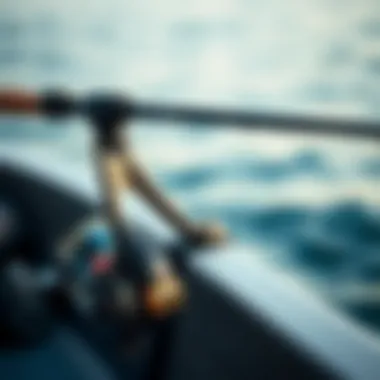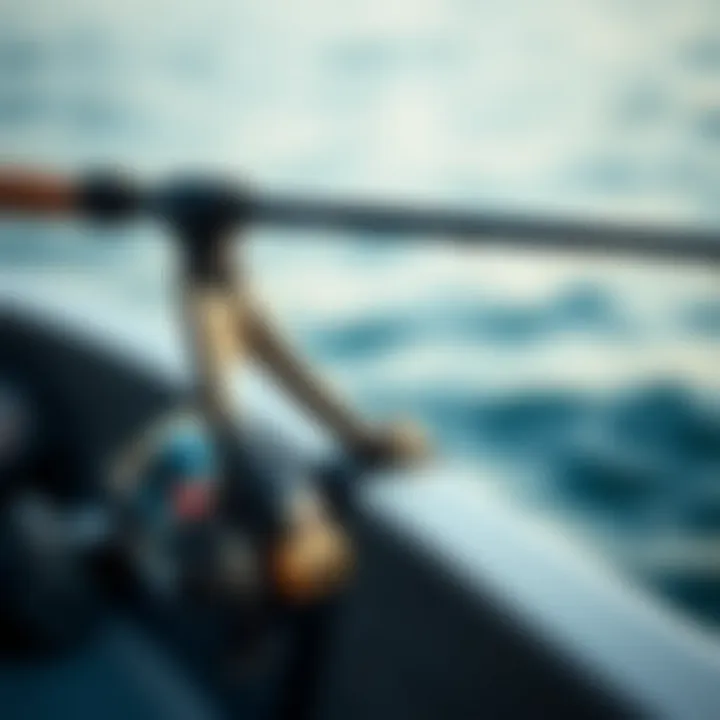Mastering Sling Shot Fishing: Techniques and Insights


Intro
Sling shot fishing is a captivating technique that combines precision and strategy, leading to rewarding experiences on the water. It’s not just about flinging bait; rather, it’s a refined art form that can significantly elevate one's fishing game. This method offers anglers an opportunity to engage with the environment in a unique way, and it requires patience, skill, and a deep understanding of the aquatic habitat.
The thrill of executing a well-placed cast or launching bait towards an elusive catch truly sets slingshot fishing apart. More than a mere fishing technique, it reflects a blend of traditional methods and modern insights, making it well-suited for both new fishers and seasoned veterans. With the right gear, methodologies, and a grasp of safety protocols, anyone can master this approach.
Through this comprehensive guide, we delve into the essential techniques, equipment specifics, and safety measures integral to successful sling shot fishing. Whether you’re casting into calm lakes or navigating twisting riverbanks, there's much to learn that caters to your skill level and interests.
Let’s embark on this journey together, unraveling the threads that weave the intricate tapestry of slingshot fishing.
Understanding Sling Shot Fishing
Sling shot fishing, while a niche corner of the angling world, brings with it a wealth of enjoyment and technique that is often overlooked. This type of fishing requires not just an understanding of how to cast efficiently but also a keen eye for the nuances of the water. Getting to grips with sling shot fishing can mean the difference between a day spent with line untangled and one filled with the frustration of missed catches. It's about finesse, precision, and employing strategies that take the fishing experience to a whole new level.
One fundamental aspect of understanding sling shot fishing is aiming to successfully target specific fish species. Whether you're after bass, perch, or trout, knowing how each of these fish behaves can greatly increase your chances of a fruitful outing. Beyond that, the technique itself demands a unique set of skills, which can take time to master. But when done correctly, it’s a rewarding experience — not only catching fish but also honing a skill that very few have mastered.
Moreover, there’s a palpable excitement surrounding this technique, as it evokes memories of childhood games. It’s a reminder that fishing doesn’t always have to be about waiting patiently with a bobber; sometimes, it’s about the thrill of launching bait with speed and accuracy. The benefits of this method extend not only to the enjoyment of the angler but also to the efficiency of catch.
Definition and Overview
At its core, sling shot fishing is a method that modifies classic fishing techniques. It employs a sling shot or catapult-like device to launch bait into water—often at targets that are either unreachable or less accessible. This allows anglers to cover a larger area while minimizing noise, which can frighten fish away.
The simplicity of the gear contrasts with the complexity of the skill involved. Rather than merely tossing bait into a body of water, the angler engages in a more dynamic form of casting that can yield better results. Essentially, sling shot fishing breaks the mold of traditional casting, leveraging the physics of momentum and accuracy. This duality effectively marries precision with adventure, making it an appealing choice for those looking to experiment with their fishing practices.
Historical Context
Sling shot fishing, albeit viewed as a modern innovation, has roots that stretch back to ancient practices. Early civilizations likely employed similar techniques to catch small fish or other water-dwelling creatures. In many cultures around the globe, fishing was often a necessary survival skill, leading to a variety of methods developed over the centuries.
As time passed, the methods employed have evolved, influenced by local customs, available materials, and even the types of fish prevalent in certain waters. Some cultures used hand-made slingshots or slings to launch bait; others integrated a more complex array of tools and technology.
In the modern era, sling shot fishing has gained recognition not solely as a technique but as an art form that is celebrated in angling communities. Its rise in popularity showcases the intertwining of fishing with personal expression and innovative thought. Today, enthusiasts can find detailed instructional resources and videos online, enhancing their understanding and practice of this unique technique. The sport has also found a home in competitive fishing events, highlighting how it transcends mere hobbyism and enters the realm of skilled sport.
Essential Equipment for Sling Shot Fishing
When it comes to sling shot fishing, having the right equipment is crucial. The tools you utilize can make the difference between landing that prize catch or coming home empty-handed. As you navigate through this thrilling angling technique, understanding the essential gear will equip you for success.
Sling Shots: Types and Varieties
Sling shots may seem simple, but there's a variety to choose from. They can range from basic wooden models to laser-crafted pieces, each with unique features.
- Traditional wooden sling shots: These are often preferred by purists who enjoy a classic feel. Wooden frames give a certain heft and balance that many anglers find comfortable.
- Metal frame models: These are durable and almost indestructible. While they may be heavier, their precision can be a game-changer.
- Pocket sling shots: Compact and portable, these are perfect for those who want to travel light. They can fit snugly in your backpack, making them easy to carry.
The choice of sling shot can depend on personal preference, and it’s worth trying several types to find which suits your style best. If you want something that feels like an extension of yourself, the right sling shot is a must.
Choosing the Right Fishing Line
A fishing line may seem like just another part of the gear, yet it can be a crucial element. The right choice can influence your results significantly. Look for these key factors when selecting your fishing line:
- Strength: You’ll want a line that can handle the weight of the fish in your target area.
- Material: Options such as monofilament, fluorocarbon, and braided lines each come with distinct advantages. Monofilament is forgiving and stretches, fluorocarbon is nearly invisible underwater, and braided lines offer high sensitivity and strength.
- Diameter: A thinner line means less visibility in the water, but also limits strength. Strike a balance based on your fishing conditions.


In essence, getting the right fishing line is about matching your fishing style to the conditions you'll encounter. A well-matched line can help avoid mishaps and ensure you stay in control when reeling in.
Bait Selection
Bait is the enticing element that can make or break your success. Selecting the right bait involves understanding the species you’re targeting and what it prefers to eat. Here are some considerations:
- Live bait: Worms, minnows, or even insects can be very effective. Their natural movements attract fish your way.
- Artificial lures: These can range from flashy spoons to realistic soft plastics. Choose colors that mimic the local fish diet or attract attention in murky waters.
- Scent baits: Adding scents can further entice fish, especially when visibility is low. Brands offer products like garlic or fish oil that can be effective.
"The bait you choose is an invitation to the underwater world. Make it enticing, and you’ll likely have guests!"
Knowing the common fish in your area’s waters and their dietary habits will help hone your bait selection. A thoughtful approach to this aspect can result in more catches and memorable fishing trips.
In closing, the equipment you bring to the sling shot fishing experience is not just gear; it's your toolkit for adventure and success. Invest time in understanding your options, and ensure everything you choose aligns with the unique conditions you'll face out on the water.
Techniques and Methods
Understanding the techniques and methods behind sling shot fishing is crucial for anyone hoping to become proficient in this unique style of angling. The various techniques not only enhance your chances of catching fish but also increase the overall enjoyment of the fishing experience. This section aims to unravel the essentials of sling shot fishing techniques and the significant advantages they impart to anglers.
Mastering the Sling Shot Technique
The sling shot technique might seem straightforward at first glance, but mastering it requires patience and practice. It’s like riding a bike; once you get the hang of it, you’ll never forget—but the process can be a bit wobbly. Proper execution involves several key elements:
- Grip and Stance: Finding the right grip on the sling shot and positioning your feet correctly can significantly influence your shot accuracy. Stand with your feet shoulder-width apart, knees slightly bent. This stance keeps you balanced as you aim.
- Aiming: Focus on your target. It’s helpful to visualize the fish—or, for that matter, even a floating lure—before you commit to taking that shot. Some anglers find it beneficial to practice aiming at non-living targets before hitting the water.
- Release: Timing is everything. A quick release can send your bait sailing just right. The best way to practice this is by using some soft objects as stand-in for your bait, training yourself to unleash at just the right moment to maximize distance and accuracy.
"A good angler must be patient, yes, but also decisive. Trusting your instincts pays off more often than not."
Targeting Specific Fish Species
Different fish species typically react differently to your sling shot technique. Understanding this variance can be the difference between a fruitful day on the water and coming home empty-handed. Familiarize yourself with local fish behavior, as it can inform your approach:
- Trout: Known for being picky eaters, they often prefer smaller, more subtle baits. A person might consider using lightweight line to intricately place bait where trout would typically hang out.
- Bass: More aggressive and willing to chase bait, larger and more vibrant offerings can attract them. Maintaining a steady pull can sometimes trigger predatory instincts to bite.
- Panfish: Small and usually in large schools, if you can get your bait right into the middle of where they congregate, you'll be likely to get a few bites.
By honing in on the specific habits and preferences of the species you are targeting, you can adjust your sling shot technique to improve the chances of a catch.
Adjusting to Environmental Conditions
Fishing is as much about adapting to the environment as it is about technique. One day the water could be glassy, making the fish a bit more cautious, while on another, a thunderstorm might spur them into a feeding frenzy. Here are some factors to consider:
- Water Clarity: In clear water, be wary of using bright colors that could scare fish away. Natural, soft tones often work better here.
- Wind: Wind can be both a friend and a foe. It might take your setup farther downwind, but can also create rougher surfaces making fish less willing to bite due to disturbance.
- Weather Patterns: Temperature changes, such as sunny afternoons versus cool evenings, will affect fish activity. Being observant and adjusting your timing accordingly can lead to improved catches.
By being acutely aware of the environmental factors and adapting your approach, including the techniques used with your sling shot, you can craft a tailored fishing strategy that works in your favor.
Optimal Locations for Sling Shot Fishing
Finding the right spot to utilize sling shot fishing techniques is akin to a sculptor discovering the perfect block of marble to bring their vision to life. The location not only significantly impacts one’s success rate but also enhances the overall fishing experience. Different settings can change the game dramatically, from determining fish behavior to influencing the effectiveness of various techniques and gear.
Freshwater vs. Saltwater Locations
When it comes to choosing between freshwater and saltwater for sling shot fishing, each option presents distinct advantages and challenges.


In freshwater, anglers often find themselves in serene lakes, winding rivers, or tranquil ponds. Freshwater environments tend to have well-defined spots with plenty of cover, such as fallen branches or submerged rocks, which attract fish. Techniques can vary based on current and depth. For example, casting near the edges where vegetation thrives can yield better results. Not to forget, identifying optimal times, like early morning or late afternoon, when fish are most active, can create a productive outing.
On the other hand, saltwater fishing often introduces additional complexities. Coastal areas, bays, and even estuaries serve as hotspots. Here, factors like tides play a crucial role. Fish are often more plentiful during certain tidal phases, meaning timing your trips with these natural rhythms can lead to a fruitful day on the water. Moreover, bait selection might need adjusting, as saltwater species generally have different feeding habits and preferences when compared to their freshwater counterparts.
Identifying Productive Spots
Locating productive spots is a sophisticated dance between experience and instinct. Several indicators can suggest potential hotspots for sling shot fishing.
- Shelter and Structure: Look for areas with ample cover for fish—this can include submerged structures, overhanging vegetation, or rocky outcrops. Fish tend to congregate where they feel safe.
- Water Movement: Rivers and streams with bubbling waters often create oxygen-rich zones that attract fish. It’s essential to pay attention to currents and how they interact with the local topography.
- Temperature Gradients: Understanding how temperature affects fish behavior can give anglers an edge. Fish prefer certain temperature ranges, so using a thermometer can help identify these zones.
- Seasonal Patterns: Different seasons bring varied fish activity. Knowing what species are in season, their spawning habits, and behavioral changes throughout the year can direct you to productive locations.
"The key to success in sling shot fishing is not just the technique but also being in the right place at the right time."
By wisely selecting locations and targeting the right conditions, anglers can turn outings into enjoyable and successful adventures on the water. It’s all about reading nature’s signs and adapting to the behaviors of the fish you aim to catch.
Safety Considerations
Safety should always take precedence in any fishing activity, including sling shot fishing. This method may appear straightforward, but it possesses inherent risks that necessitate careful attention. Numerous factors come into play that can impact the overall safety of the angler while ensuring a gratifying experience on the water. Some essential elements to consider include personal safety gear, environmental awareness, and a robust understanding of local regulations.
Proper planning and the right gear can significantly influence one's safety level while sling shot fishing. Ensuring adequate protection not only enhances the likelihood of a successful fishing trip but also contributes to an enjoyable time outdoors by reducing potential hazards.
Personal Safety Gear
When embarking on a sling shot fishing expedition, wearing suitable personal safety gear becomes crucial. This means equipping oneself with items that both protect against accidents and improve overall comfort.
Here are some essential elements of personal safety gear that should not be overlooked:
- Life Vest: A proper flotation device is vital, especially in unfamiliar waters or during adverse weather conditions. A life vest offers buoyancy, ensuring that even if an unexpected situation occurs, one remains afloat.
- Non-Slip Footwear: Stability is paramount while traversing slippery surfaces. Invest in durable shoes with good grip that will minimize the risk of falling on wet rocks or boats.
- Sunglasses with UV Protection: Protecting your eyes from the harsh sunlight not only helps avoid strain but also increases visibility when targeting fish in water.
- Sunscreen: The sun can be relentless; applying a water-resistant sunscreen helps reduce the risk of sunburn during long hours spent outside.
- First Aid Kit: Accidents can happen, so having a basic first aid kit on hand is wise. This can assist in treating minor injuries that could occur while fishing.
Utilizing these safety measures can prevent potential dangers and contribute to a more successful outing.
Environmental Awareness
Understanding the environment where you're fishing is as important as personal safety gear. Environmental awareness covers various aspects from weather conditions to local wildlife. Being cognizant of these elements ensures that fishing happens within a respectful framework towards nature and personal wellbeing. Some things to keep in mind include:
- Weather Conditions: Always check the forecast before heading out. Sudden storms or changes in weather can significantly affect your fishing plans and pose serious risks.
- Local Wildlife: Be aware of the local fauna. Certain areas might house creatures, such as snakes or insects, which can be hazardous if ignored. Recognizing their habitats and behaviors can prevent unpleasant surprises.
- Water Conditions: Recognizing currents and tides can be vital for your safety. Knowledge of the conditions allows for better positioning and helps in recognizing when it’s time to retreat or adjust your fishing techniques.
- Leave No Trace: Practicing environmentally sustainable fishing helps protect natural resources. Always adhere to the principle of keeping the environment clean and minimizing your impact. Take out what you take in, leaving the area pristine for future anglers.
Awareness of both personal safety and the surrounding environment significantly enriches the overall fishing experience while mitigating risks.
By focusing on these safety considerations, anglers can not only protect themselves but also cultivate a deeper appreciation for the outdoor spaces where they fish. Engaging with nature mindfully yields a fruitful experience that can be cherished for years to come.
Legal Regulations and Best Practices
Understanding the legal framework surrounding sling shot fishing is essential for every angler, whether you’re a novice or a seasoned expert. Following the rules set by local authorities not only helps in preserving the ecosystem but also ensures a smooth fishing experience without unnecessary legal entanglements. This section dives into the importance of staying updated on fishing regulations and adopting best practices, ultimately benefiting both the fish and the angler.
Understanding Local Fishing Laws
Each region has its own set of fishing regulations, and sling shot fishing is no exception. These laws can cover a range of aspects, such as harvest quotas, size limits, and restricted seasons:
- Species Protection: Many laws exist to protect specific fish species that may be endangered or threatened. Knowing which species are protected in your area is crucial. For instance, if you're fishing in a lake where the native trout populations are at risk, fishing them could result in hefty fines.
- Seasonal Restrictions: Some regions enforce seasonal bans to ensure fish populations remain sustainable. Anglers may need to wait for specific seasons to fish certain species successfully. Always consult local resources to stay informed.
- Size and Bag Limits: Adhering to size limits helps maintain the health of fish populations. The regulations usually stipulate what length of fish is legal to catch and how many you can keep in a day. Ignoring these rules can result in penalties.


Be aware that a quick call to your local fish and game office can offer insight into the most current regulations. Resources like *.gov local fishing regulations provide a comprehensive view of laws specific to different areas. By respecting these guidelines, you contribute to the sustainable practice of fishing, fostering a habitat where wildlife can thrive.
Conservation Efforts
Conservation is the name of the game when it comes to sustainable sling shot fishing. By participating in conservation efforts, anglers can actively contribute to the protection of aquatic ecosystems. Here's how:
- Joining Local Initiatives: Many communities host events to clean up waterways or restore fish habitats. Getting involved in such activities is not just beneficial for the environment; it also strengthens your connection to the local fishing community.
- Education: Staying informed about the ecological impacts of fishing methods is essential. Techniques like sling shot fishing can be more eco-friendly compared to traditional fishing methods as they might cause less disturbance to habitats. Learning about these impacts can guide responsible fishing practices.
- Reporting Violations: As members of the fishing community, it’s vital to advocate for responsible fishing. If you observe illegal activities, reporting them can help protect your fishing grounds.
Engaging in conservation is not just a duty; it’s an opportunity to give back to the waters that offer us so much enjoyment. Every effort counts, from keeping the waterways clean to practicing catch-and-release strategies.
Advanced Techniques for the Experienced Angler
Advanced techniques in sling shot fishing are crucial for those who are looking to up their game and enhance their angling experience. Mastering these methods not only enables more precision and efficiency but also paves the way for exploring different styles of the craft. This section will delve into specific elements of sling shot fishing that stand out for seasoned anglers, discussing the benefits, necessary considerations, and how they can further the angler's skills.
Sling Shot Variations
Understanding the variations in sling shot techniques can elevate an angler’s performance considerably. Each variation has its own merits and can be suited to different fishing environments. For instance, an angler might prefer the Daisy Chain approach when fishing in areas with dense foliage, or the Swinging Method that’s more effective in open waters.
- Daisy Chain: This method consists of launching multiple baited hooks in succession using a specially modified sling shot. It creates a spread, increasing the likelihood of attracting various species.
- Swinging Method: Here, the sling shot creates a swinging motion, allowing for longer casts. This is particularly useful when trying to reach deeper waters where fish are lurking.
- Underhand Cast: Much like a frisbee throw, you hold the sling horizontally to launch, which can work wonders in tight spots.
By emulating these variations, you can adapt to your fishing surroundings efficiently, ensuring you are always one step ahead of your target species.
Using Technology to Enhance Skills
With advancements in technology, anglers are not limited to just traditional methods anymore. Technology provides tools that can significantly improve skills in sling shot fishing.
Smart Fishing Apps allow users to track weather patterns, monitor fish activity, and even share catch reports with fellow anglers. This information can be crucial for planning your fishing trips.
Fish Finders have also become popular. These devices use sonar to detect fish beneath the water's surface, giving you an edge in knowing where to aim your sling shots. Imagine knowing exactly where the fish are—what a time saver!
For those who are looking to refine their aim, practice with Laser Sight Attachments can help. It provides visual feedback on your shooting accuracy, allowing you to make necessary adjustments effectively.
In summary, incorporating variations and technological advancements can enhance an angler's skills, offering a competitive edge on the water. Whether you opt for creative cast styles or smart tech, the objective remains to optimize your fishing experience—catching more fish in less time, with greater ease.
Epilogue
The importance of the conclusion in any article cannot be understated, particularly in a detailed exploration like this one on sling shot fishing. It serves as the final touch, wrapping up all the insights and techniques discussed, essentially distilling the vast information down to its core significance. For those who embrace this fishing style, understanding the nuances highlighted throughout promotes not just proficiency but also respect for the craft.
Reflecting on Sling Shot Fishing
As we delve deeper into the art of sling shot fishing, it becomes clear that this technique is far more than just a method to catch fish. It's a blend of precision, patience, and passion. Anglers often find themselves drawn to the rhythmic motion of launching bait with a sling shot, a dance of sorts between man and nature.
Sling shot fishing challenges both skill and mindset. It calls for sharp focus and awareness, as the angler must read water conditions, fish behavior, and even environmental cues. Some anglers liken it to archery; the feeling of hitting the target, that moment of connection with the fish, provides a rush that’s hard to find elsewhere.
Reflecting on the broader implications, sling shot fishing also holds cultural and community significance. Many regional fishing tournaments feature this technique, spreading knowledge and fostering camaraderie among anglers. Essentially, it celebrates the art of fishing while advocating for sustainable practices that ensure future generations can also enjoy the thrill of the catch.
Future Trends in Sling Shot Fishing
Peering into the future, several trends are shaping the landscape of sling shot fishing. Firstly, advancements in materials and design of slingshots themselves are increasing accuracy and enhancing user experience. Lightweight, durable materials manufactured through innovative methods promise better performance with less strain on the angler.
Moreover, the integration of technology cannot be overlooked. Anglers are beginning to utilize apps that help track local fish populations and environmental variations, aiding in more strategic planning before heading out. Technology is enhancing not merely skills but also the safety aspects of fishing by providing real-time weather updates and local regulations.
As sustainability becomes a central tenet in outdoor recreation, future sling shot fishing practices might intertwine even more with conservation efforts. Educating anglers on responsible fishing techniques and contributing to ecological balance will likely be focal points moving forward. Ultimately, sling shot fishing stands at a crossroads of tradition and innovation, promising a rich and evolving future for enthusiasts both new and seasoned.
"Fishing is more than just a sport; it's a lifestyle that encourages appreciation for nature and the responsibility to protect it."
For more resources on sling shot fishing and techniques, you might explore resources like Britannica, Wikipedia, and for community discussions, consider platforms like Reddit or social media groups on Facebook.







